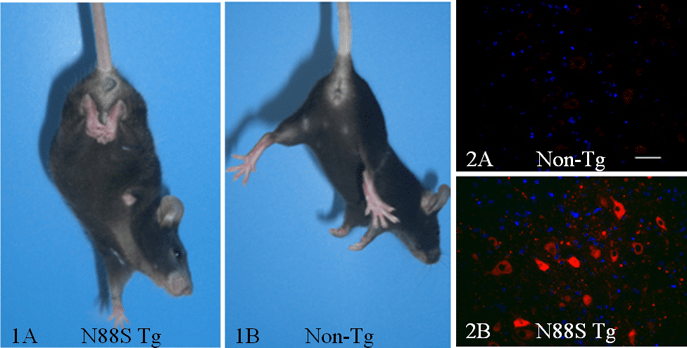Neurodegeneration via endoplasmic reticulum stressB6;B6D2-Tg(Thy1-BSCL2*N88S)1 RBRC05350
Fig. 1. Abnormal limb reflexes in N88S Tg mice. Upon tail elevation, N88S Tg mice (A) held their hind limbs close to their body, while Non-Tg mice (B) showed the normal escape response by splaying their hind limbs. |
Heterozygosity for mutations (N88S and P90L) in the N-glycosylation site of seipin/BSCL2 is known to cause several neurodegenerative diseases, collectively referred to as “seipinopathies”. The results of previous in vitro studies suggested a close association between seipinopathies and endoplasmic reticulum (ER) stress [1]. To investigate the molecular mechanism of seipinopathies in vivo, a transgenic (Tg) mouse expressing the human N88S seipin mutant under the control of the murine Thy-1 promoter has been generated [2]. These N88S seipin Tg mice exhibited progressive motor impairment (Fig.1), inclusion bodies in the cerebral cortex and spinal cord, reactive astrocytosis in the spinal cord, neurogenic muscular atrophy, and axon degeneration in the peripheral nerves. These symptomatic and pathological conditions are a good model of the phenotype observed in human patients with seipinopathy. Moreover, it was clearly shown that ER stress markers were up-regulated in the mutant mice (Fig.2). Thus, molecular and pathological analyses of the N88S seipin transgenic mice have provided new findings to understand the relationship between ER stress and neurodegenerative disorders. The N88S seipin Tg mouse is a useful tool for developing novel therapies against ER stress-related diseases.
| Depositor | : | Dr. Daisuke Ito, Keio University | |
| References | : | [1] | Ito D and Suzuki N. Molecular pathogenesis of spipin/BSCL2-related motor neuron diseases.Ann Neurol 61:237-250, 2007 |
| [2] | Yagi T, Ito D, Nihei Y, Ishihara T, Suzuki N. N88S seipin mutant transgenic mice develop features of seipinopathy/BSCL2-related motor neuron disease via endoplasmic reticulum stress. Hum Mol Genet 20:3831-3840, 2011 | ||






